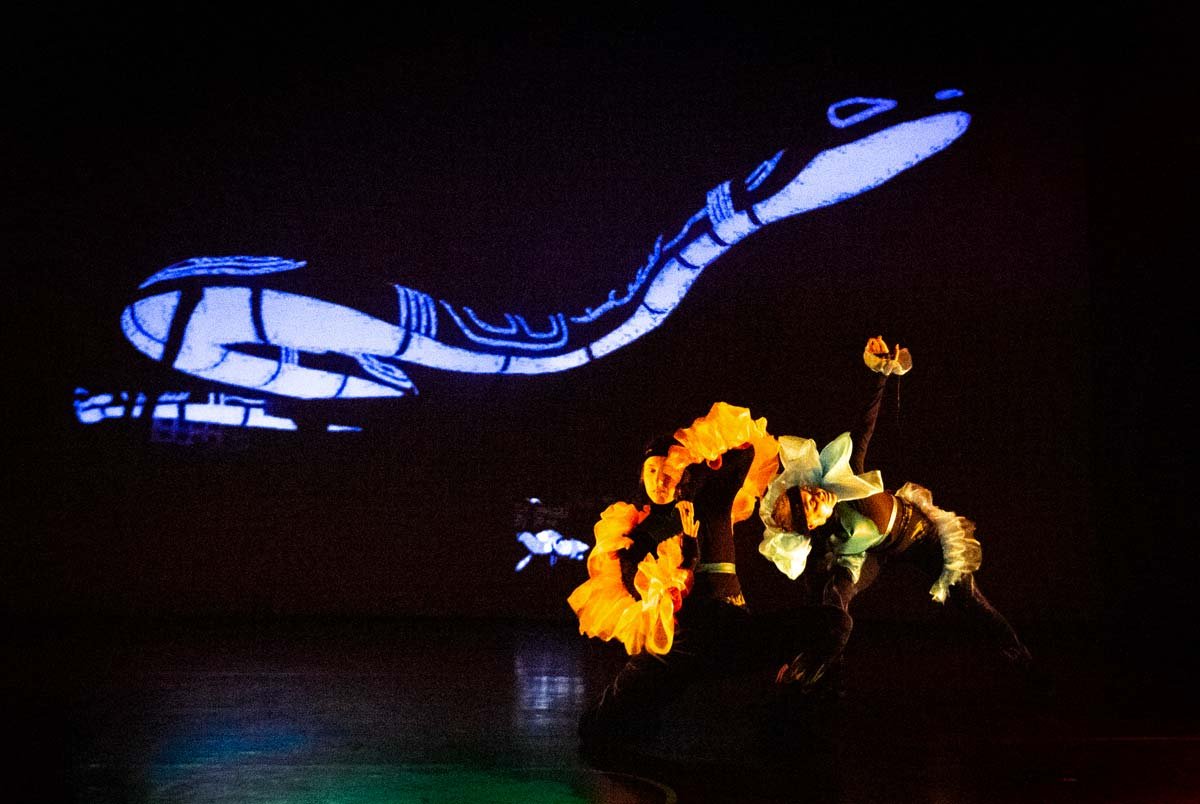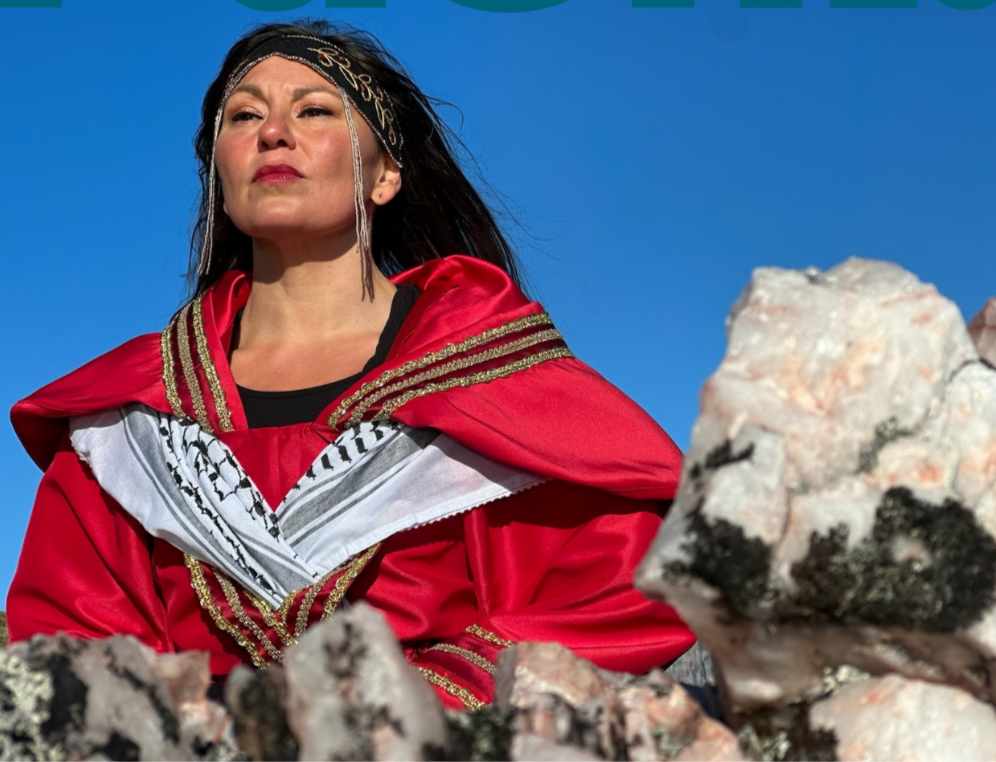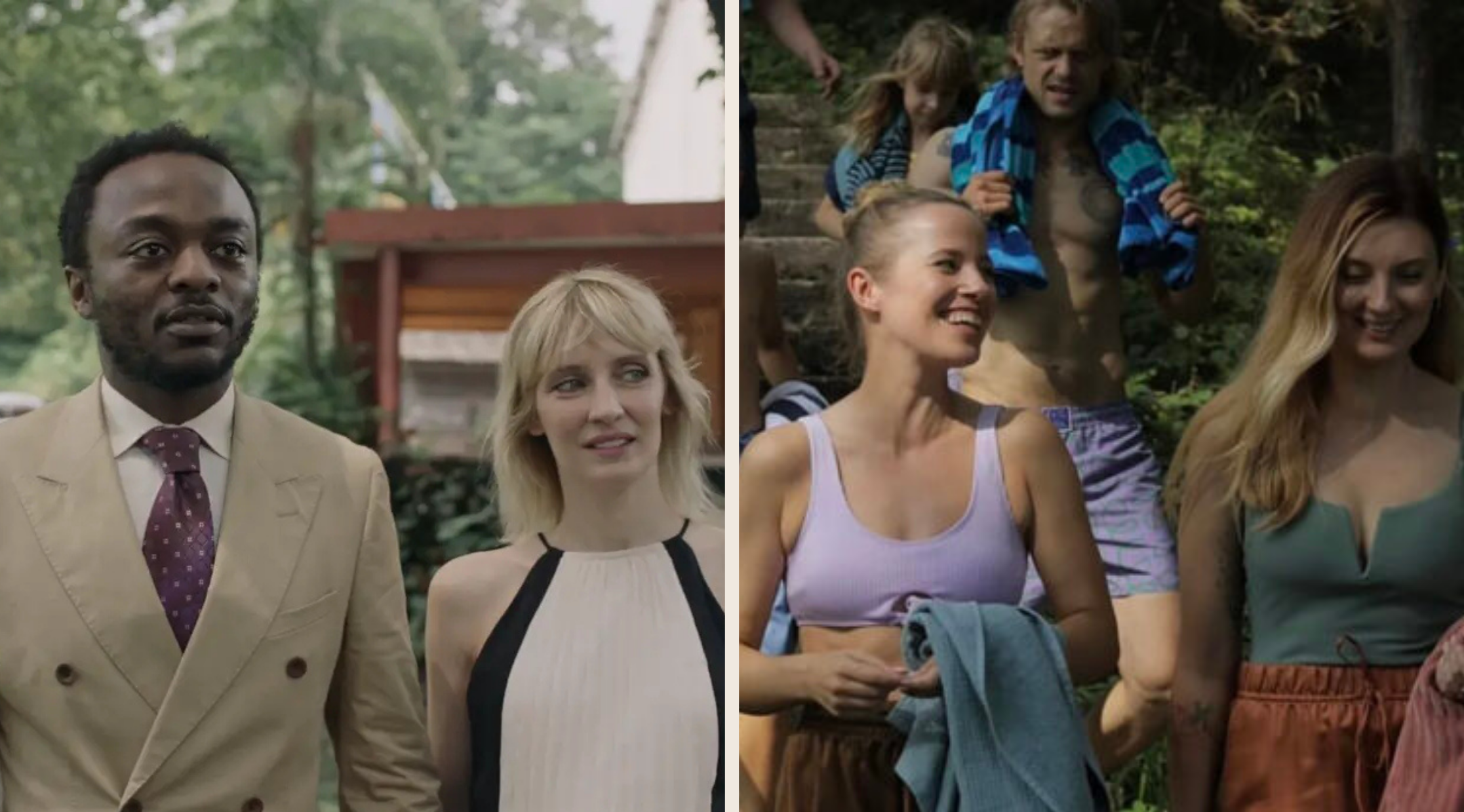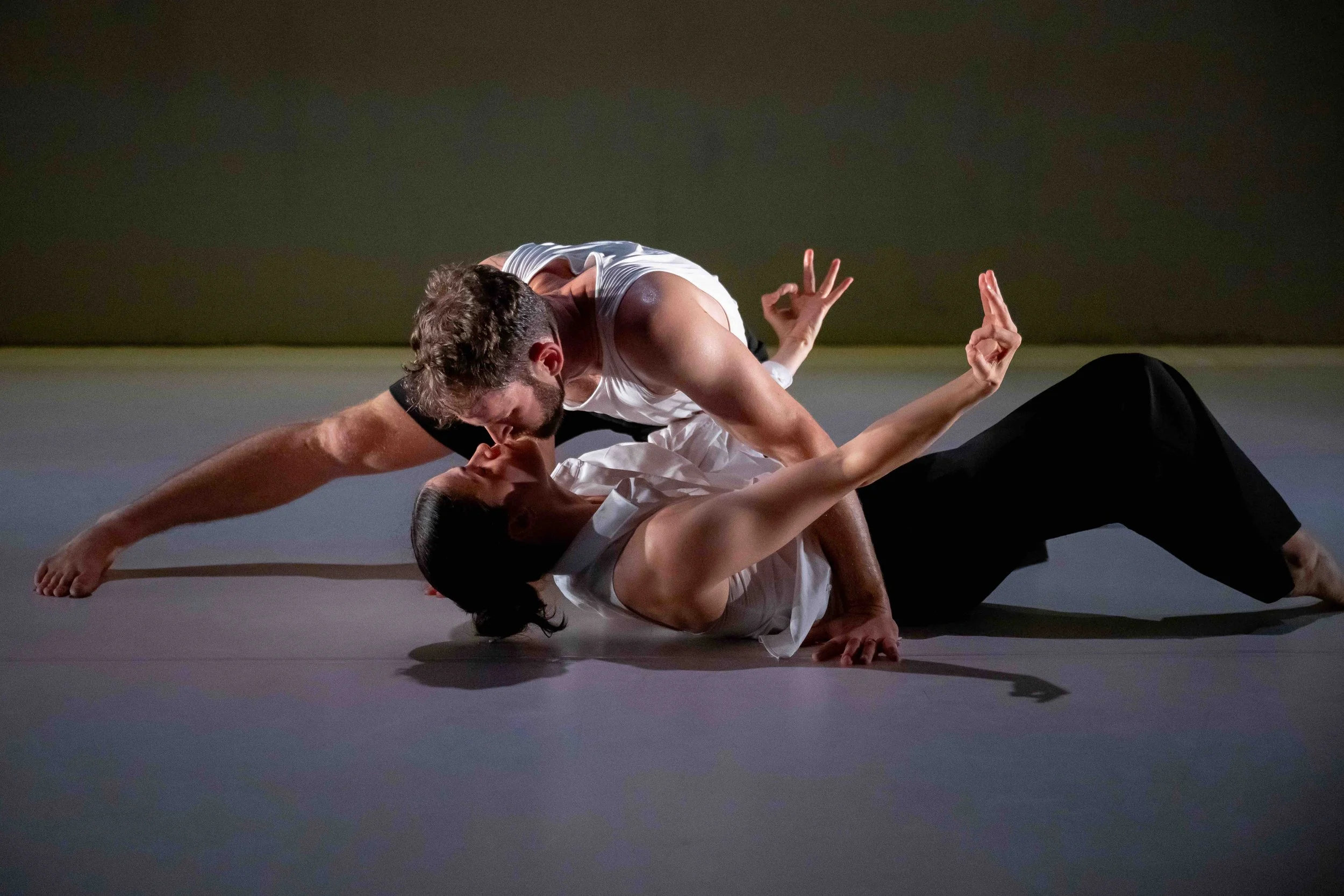Matriarchs Uprising employs tech to take female contemporary Indigenous dance into the future
The multifaceted festival features everything from VR films to dancing avatars while remaining rooted in ancestral world views
Homelands—Yakón:kwe by Kaha:wi Dance Theatre (Santee Smith). Photo by Shane Powless
O.Dela Arts in partnership with The Dance Centre presents Matriarchs Uprising from February 13 to 18 at The Dance Centre and online
INDIGENOUS FUTURISM IS the theme of the fifth annual Matriarchs Uprising, a performance festival that celebrates contemporary female Indigenous dance. When Olivia C. Davies, the event’s founder and artistic director, reflects on the idea of looking forward, she thinks of a timeless philosophy rooted in her Anishnabe ancestry.
“In Anishinaabemowin we have a term called ‘Mino Bimaadiziwin’, or ‘the good life’,” Davies says in a phone interview with Stir. “The good life, as I understand it as an Anishinaabe-Kwe [female], it’s a way of setting the intention of finding the good life. There aren’t necessarily clear road maps beyond having our cultural teachings, having our language, and having a sense of ‘how did they do it before today? And ‘How can we continue to learn to bring about a better future for generations to come?’
“Hopefully we’re all thinking about that as we move into 2023,” adds Davies, whose mixed background also includes French Canadian, Finnish, and Welsh heritage. “It’s been really interesting to feel the shift into a futuristic approach to how we’re sharing our stories with new technologies that are more and more available to us.”
As an example, consider a VR film that’s on the lineup at this year’s Matriarchs Uprising. TOMO VR from Aotearoa/New Zealand-based Atamira Dance Company captures a dream space as it tells a tale of life and death while viewers witness two travelling wairua (the bodiless self) and generations of ancestors before them. (It screens February 16 to 18.) “It does bring a beautiful choreography through to audiences in this new technology but also shares a story that comes from a dream the choreographer had of these generational experiences and the blood memory that moves through us,” Davies says. “I look to that work and the works of the other individual artists, which all bring about these ideas of: ‘What does it mean to be present with an understanding of the past that can bring us forward into the future in a good way?’.”
Olivia C. Davies.
The festival’s 2023 edition also offers live performances, circle conversations, masterclasses, educational workshops, and an online film series. Curated by Davies, Matriarchs Uprising features new contemporary dance works by Kaha:wi Dance Theatre, Sophie Dow, Samantha Sutherland, O.Dela Arts and Pepper’s Ghost Media Collective, Bella Waru and Irihipeti Waretini, Kayla Briët, Kelly Nash and Nancy Wijohn, Olivia Shortt, Sandra Lamouche, and DTES Grandmothers Collective. The purpose is to highlight emerging and established Indigenous contemporary-dance artists while bringing the artform to audiences of all backgrounds.
“I look to my fellow friends and colleagues, other Indigenous women, who are creating work and creating new ways of expressing our Indigeneity and finding that platform that brings those visions, those hopes, and those ideas out into a wider public, especially with regards to how it’s been such a beautiful thing to see Indigeneity come to the forefront of mainstream conversations today,” Davies explains. “Matriarchs Uprising can be a platform for our Indigenous women who are nurturing the art of contemporary dance to bring their ideas forward and share them with a wider audience—as well as sharing with one another, what we’re dreaming about, how we’re practising, and how we’re bringing our culture forward.”
Ñswe niiminwinan (3 Dances) (February 17) is a collection of three new solo performance works: journals of adoption by Sophie Dow, kaqwiⱡȼi by Samantha Sutherland, and Homelands —Yakón:kwe by Kaha:wi Dance Theatre.
In journals of adoption, Dow travels through two journals of origin: one from her birth mother's pregnancy and process of offering her up; and one from her adoptive mother’s experience of receiving a child.
kaqwiⱡȼi grew out of Sutherland’s practice of translating words and stories from the Ktunaxa language into movement. The piece explores tales the artist’s Elders have told her as well as her journey of learning her language.
A multidisciplinary work that encompasses earthy and cinematic media, sound design, and performance is Kaha:wi Dance Theatre’s Homelands—Yakón:kwe. Created by the company’s artistic director, Santee Smith, it places Yethi’nihstenha (many womxn) within their ancestral homelands and waters in Kahnyen’kehàka territory of upper state New York and around the Six Nations of the Grand River territory. The solo is an excerpt of a full-length work having its world premiere later this year. “Her artistry is one of the ones that inspired me to move in this direction,” Davies says of Smith. “I’ve been quite the fan boy for a long time of Santee Smith and Kaha:wi Dance Theatre and everything she and her company have done for Indigenous dance companies over their span and their trajectory. But I’ve also been someone who just really loves to see Santee onstage and to experience her storytelling through movement.”
Maamawi (ᒫᒪᐏ): Together Through The Fire. Photo by O.Dela Arts
On February 18, Matriarchs Uprising will present the world premiere of Maamawi (ᒫLᐏ): Together Through The Fire, a collaboration by O.Dela Arts and Pepper’s Ghost New Media Collective. An expression of the Anishinaabe Seven Fire Prophecies, as shared by Anishinaabe Elder Gloria May Eshkibok, Maamawi takes its name from the Anishinaabemowin word for “together”. Choreographed by Davies, the work is intended to be experienced as both a live theatrical performance with MoCap technology and an interactive VR and AR experience by creative technologist Athomas Goldberg. Moving to an original music and sound design by Michael Red, dance artists Dow and Daisy Thompson will travel through different environments accompanied by their digital avatars designed by Ojibway Woodland artist and illustrator Joshua Mangeshig Pawis-Steckley. Using real-time motion-capture techniques, the dancers’ motions will be captured in real-time and used to drive the animated avatars and visual imagery, which will then be projection-mapped onto surfaces behind and around the performers. This will simultaneously fill the 3D space of an online immersive multiplayer virtual-reality environment that remote audiences can connect to and enter from around the world.
“The fully fleshed-out production feels like a closing of a chapter and the opening of a new beginning to how we can start to have conversations about what does it mean to bring these new technologies of motion capture and virtual reality into dance experience,” Davies says, “and how those technologies help us in sharing our stories beyond people sitting in the audience in the theatre with us.”
The festival’s intergenerational DTES Grandmothers’ Collective Residency will present a live performance (which will also be livestreamed) on February 17, the culmination of its second Gathering Hope residency at Morrow, in partnership with Dumb Instrument Dance. This season’s members include Dalannah Gail Bowen, Rosemary Georgeson, Sharon Jinkerson-Brass, and Savannah Walling, along with dance artists Rianne Svelnis, Ziyian Kwan, Davies, and Dow. The live presentation is in a sense a ceremony space for movement, dance, story, song, and sharing, Davies explains, adding: “How I look at this and my real intention last year carries forward this year: How can I continue to learn from my artistic mentors, the Elder community of arts creators and storytellers, and bring in that intergenerational learning and knowledge exchange?”
Dow and Sutherland are O.Dela Arts’ artistic associates who co-curated the festival’s Dance Film Series, which has a theme of Indigenous Futurism—Stories of Transformation. Featuring works by Indigenous artists from around the globe, it runs on demand from February 13 to 18.
For Davies, dance is a transcendent way to communicate and connect—with others, with herself, with her ancestors, and with the world around her.
“It’s always been a matter of sharing beyond words, sharing beyond my ability to tell stories simply with my thoughts and my language but to moving the body in a way that connects deeply with my heartbeat, with the blood memory that courses through my veins, knowing that my heartbeat can connect with the witnesses who are in the space with me as we breathe together, as we feel the rhythm and the pulse of the environment, of the space, of the lighting, of the music, of the soundscape, and we can be in a ritualistic moment and share in that brief experience of togetherness. dance will always be that to me whether I’m dancing alone in my kitchen and feeling the spirit of every being around me and those who came before me, those who will come after me, knowing that dance connects me to a much wider world that is the dance of our nature, of our environment, our experience on this Earth in this time.”















